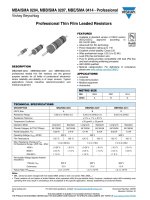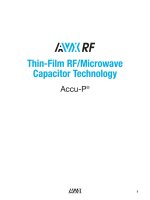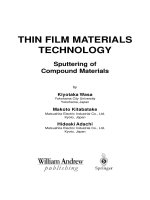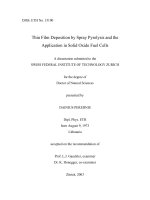thin film deposition
Bạn đang xem bản rút gọn của tài liệu. Xem và tải ngay bản đầy đủ của tài liệu tại đây (10.66 MB, 167 trang )
DISS. ETH No. 15190
Thin Film Deposition by Spray Pyrolysis and the
Application in Solid Oxide Fuel Cells
A dissertation submitted to the
SWISS FEDERAL INSTITUTE OF TECHNOLOGY ZURICH
for the degree of
Doctor of Natural Sciences
presented by
DAINIUS PEREDNIS
Dipl. Phys. ETH
born August 9, 1973
Lithuania
accepted on the recommendation of
Prof. L.J. Gauckler, examiner
Dr. K. Honegger, co-examiner
Zürich, 2003
This thesis is dedicated to my parents
Aldona
(1952-2003) and Bolius Perednis
Acknowledgement
This book is dedicated to my parents Aldona
and Bolius Perednis for their full
confidence, constant care and support during all these years at home and in Switzerland.
I would like to thank my advisor Prof. Dr. Ludwig J. Gauckler for the opportunity
to realize this thesis in his laboratory, for the freedom in managing this project, for his
encouragement and support throughout this thesis. During the stay at his institute I have
learnt a lot about ceramics in general. In particular, I wish to thank him for the possibility
he gave me to present my work at international conferences all over the world.
Special thanks to Dr. Kaspar Honegger (Sulzer Innotec AG) for acting as co-
examiner of the thesis and also for giving me an experimental assistance.
The quality of this manuscript was improved significantly by the help of many
people, especially Prof. Dr. Gerhard Bayer
, Brandon Bürgler, Nicholas Grundy, Michael
Jörger, Dr. Claus Schüler. I appreciate their valuable suggestions and patience to read the
manuscript.
Furthermore, I wish to thank all the colleagues at the group of Nonmetallic
Inorganic Materials and many other people, in particular:
Oliver Wilhelm (The Particle Technology Laboratory) for help in counting droplets
and discussions on spray pyrolysis.
Prof. Dr. Sotiris E. Pratsinis (The Particle Technology Laboratory) for helpful
discussions.
Dr. Petr Bohac and Dr. Martin Hruschka for introduction to the spray pyrolysis
technique.
Dr. Helge Heinrich (Institute of Applied Physics) for his support in transmission
electron microscopy.
My students Marc Dusseiller, Laurent Feuz, René Nussbaumer, Fernanda Rossetti,
Claudio Vanoni, Simon Oertli for significant contributions to this thesis.
Present and former members of the SOFC team: Daniel Beckel, Dr. Anja Bieberle,
Eva Jud, Dr. Christoph Kleinlogel, Ulrich Mücke, Michel Prestat, Jennifer Rupp, Dr.
Julia Will.
Christoph Huwiler and Srdan Vasic for sharing H33 office.
Secretary Irene Urbanek for help in administrative stuff.
Martin Borer (Dega AG) for his support in all questions concerning spray guns.
Peter Kocher for his technical support.
Jeol JSM 6400 and LEO 1530 for thousands of pictures.
The financial support from the Swiss Federal Office of Energy is gratefully
acknowledged.
Special thanks to my sister Asta, her husband Kestutis, and all my friends for their
support outside the office.
I wish to express my sincere thanks to my wife Ieva for her patience, care, and
support throughout my studies.
1
Table of contents
Table of contents 1
Summary 5
Zusammenfassung 7
1 Introduction 11
1.1 Aim of the study 11
1.2 Strategy 12
2 State of the art: spray pyrolysis 13
2.1 Introduction 14
2.2 Powder production 16
2.3 Thin film deposition and applications 18
2.3.1 Films for solar cell applications 18
2.3.2 Sensors 19
2.3.3 Metal oxide coatings 20
2.3.4 Solid oxide fuel cells 21
2.3.5 Miscellaneous applications 23
2.4 Models for film deposition by spray pyrolysis 25
2.4.1 Atomization of precursor solution 25
2.4.2 Aerosol transport 27
2.4.3 Decomposition of precursor 29
2.5 Summary 33
2.6 References 34
3 Morphology and deposition of thin metal oxide films using spray pyrolysis 41
3.1 Introduction 42
3.1.1 Spray generation 43
3.1.2 Influence of spray parameters on film morphology 44
3.2 Experimental 46
3.2.1 Set-up 46
3.2.2 Chemicals and substrates 48
3.2.3 Characterization 50
3.3 Spray parameters 51
3.3.1 Substrate surface temperature 51
3.3.2 Solution flow rate 53
3.3.3 Type of salt 54
2
3.3.4 Solvent 59
3.3.5 Deposition time 60
3.3.6 Nozzle to substrate distance 61
3.3.7 Additives 62
3.3.8 Deposition rate 64
3.4 Summary 66
3.5 References 67
4 A model for film deposition by spray pyrolysis 69
4.1 Introduction 70
4.2 Experimental setup 71
4.3 Results 73
4.3.1 Pressurized Spray Deposition 73
4.3.2 Multi-jet mode of electrostatic spray deposition 77
4.3.3 Cone-jet mode of ESD 81
4.3.4 Comparison of PSD and ESD systems 84
4.4 Analysis of the deposited films 86
4.5 Decomposition of the salt solutions 89
4.6 Film growth model 93
4.6.1 Summary of the spray parameter study 93
4.6.2 Model for film deposition 93
4.7 Conclusions 96
4.8 References 98
5 Thermal treatment of metal oxide spray pyrolysis layer 101
5.1 Introduction 102
5.2 Experimental 104
5.3 Results and discussion 106
5.3.1 Structural properties 106
5.3.2 Influence of thermal treatment on film topography 111
5.3.3 Electrical properties of spray deposited films 113
5.4 Summary 116
5.5 References 117
6 Solid oxide fuel cells with electrolytes prepared via spray pyrolysis 119
6.1 Introduction 120
6.2 Experimental 123
6.2.1 Anode substrates 123
6.2.2 Electrolyte deposition 123
6.2.3 Cathode preparation 125
6.2.4 Fuel cell measurements 127
3
6.3 Results and Discussion 129
6.3.1 SOFC with a single-layer YSZ electrolyte film 129
6.3.2 Cell with bi-layer electrolyte film 133
6.3.3 Cells with composite electrolyte films 138
6.4 Conclusions 142
6.5 References 144
7 General conclusions 147
8 Outlook 149
9 Appendix 153
9.1 Measurement of droplet size distribution using PDA 153
9.2 Forces acting on droplet 154
10 Abbreviations 155
11 Curriculum vitae 157
4
5
Summary
Solid oxide fuel cell (SOFC) technology offers efficient power generation with low
emission of pollutants because it converts chemical energy directly to electrical energy.
However, cost reduction remains the main objective of SOFC development. State of the art
high temperature SOFC is based on thick (about 150 µm) zirconia electrolyte. Operating
temperatures of 900-1000°C are required due to the low specific ionic conductivity of
zirconia electrolyte and in order to avoid carbon deposition on the anodes when incomplete
reformed fuel is used. This might lead to the interfacial solid state reactions of cell
components, and place large demands on the expensive materials chosen as interconnectors
(Cr5Fe1Y
2
O
3
). Therefore, reduction of the operating temperature to 700-800°C is strongly
desirable in order to reduce system costs and to enhance reliability. Thin film zirconia-based
electrolytes contribute to minimizing ohmic losses and therefore to achieving the set goal.
Aim of this study was the development of an inexpensive manufacturing process for
thin film oxides suitable as electrolytes for SOFC. The spray pyrolysis method was chosen for
deposition of the electrolyte onto porous anode substrates. This is an inexpensive form of
coating technology with the potential to produce thin (0.1 to 10 µm) and gas tight ceramic
films.
In chapter 2 a brief overview of spray pyrolysis is presented with respect to the
working principle of this technique and its application to depositing various thin films. In
chapter 3 the most important spray pyrolysis parameters are studied. A film growth model is
proposed in chapter 4. Chapter 5 focuses on the influence of thermal treatment on the
microstructure of the deposited film. Finally, in chapter 6, the application of spray pyrolysis
to deposition of thin electrolyte films for SOFC is demonstrated and their performance is
reported.
A comparison of two spray pyrolysis techniques, Electrostatic Spray Deposition
(ESD) and Pressurized Spray Deposition (PSD), is presented in the chapter 3. For both
techniques, the substrate surface temperature is the main parameter that determines the film
morphology. Using ESD, the surface morphology is strongly influenced by the composition
of the precursor solution and deposition time. When the PSD technique is used for film
deposition, the influence of these parameters on film morphology is not pronounced.
Further insight in to the working principle of the spray pyrolysis method is given in
chapter 4. Droplet transport and evaporization is investigated using a phase doppler
SUMMARY
6
anemometer. Droplets smaller than 10 µm dominated the number distributions and in contrast,
the volume distributions were dominated by the droplets larger than 10 µm. Significant
droplet evaporation is observed at a distance of 1 cm from the substrate. A possible growth
mechanism is proposed where the substrate surface temperature and the large droplets (> 10
µm) determine the deposition process. Generally, this temperature should be higher than the
decomposition temperature of the precursor. Too low deposition temperatures lead to cracks
in the films. When the temperature is too high, rough films with particles on the surface are
deposited or powder can be produced. In contrast to most authors, the proposed film growth
model does not involve a CVD process.
Chapter 5 reports the structural analysis of the films deposited by the spray pyrolysis
technique. The influence of thermal treatment on the film microstructure is investigated.
Films with a mean grain size of 12 nm have been obtained at an annealing temperature of
700°C. No crack formation is observed during thermal treatment up to 800°C. It was
calculated that at 700°C the ohmic losses caused by electrolyte are sufficiently low when the
film thickness does not exceed 5.5 µm. From the above results it can be concluded that the
spray deposited 8 mol% yttria-stabilized-zirconia (YSZ) films would sustain the SOFC
operating temperature of up to 800°C.
The application of the spray pyrolysis technique in SOFC technology was
demonstrated in chapter 6. Spray pyrolysis allows thin electrolytes to be prepared with low
ohmic losses and thereby allows the operating temperature of solid oxide fuel cells to be
reduced while maintaining high power output. The bi-layer electrolyte films consisted of a
layer of YSZ and a buffer layer of ceria 10 mol% yttria solid solution (CYO). The electrolyte
bi-layer was deposited onto porous NiO-YSZ self-supporting anode substrates. The cells were
operated using hydrogen as fuel and air as oxidant at temperatures ranging from 600°C to
800°C and exhibited an open circuit voltage of 1.01 V at 720°C indicating a dense and crack-
free electrolyte film. A high power density of more than 750 mW/cm
2
was generated by cells
with 600 nm thin YSZ/CYO bi-layer electrolyte at 770°C. Cells containing the bi-layer
electrolytes were operated for over 450 hours at 720°C with tolerable degradation.
Surprisingly, pores with sizes of up to 3 µm could be coated by a 500 nm thin electrolyte film
using the spray pyrolysis technique.
Summarizing, it can be stated that the spray pyrolysis technique is an extremely
promising thin film deposition method. The results obtained in this thesis prove that this
technique can be successfully used in SOFC technology.
7
Zusammenfassung
Festelektrolyt-Brennstoffzellen (SOFC) ermöglichen eine effiziente Stromerzeugung
mit niedriger Emission von Schadstoffen. Sie wandeln direkt chemische in elektrische
Energie um und sind nicht dem Carnot Gesetz unterworfen. Derzeit ist die Kostenreduktion
das Hauptziel der SOFC Entwicklung. Zirkonoxid, mit einer Dicke von 150 µm, ist
heutzutage das meistverwendete Elektrolytmaterial in Hochtemperatur SOFC Systemen.
Wegen der niedrigen spezifischen Ionenleitfähigkeit von Zirkonoxid Elektrolyten sind
Betriebstemperaturen von 900°C bis 1000°C notwendig. Diese hohen Temperaturen können
Festphasen-Grenzflächenreaktion zwischen benachbarten Zellbestandteilen beschleunigen.
Hohe Stabilitätsforderungen werden auch an die Interkonnektoren gestellt, so dass nur teure
Materialien, wie z.B. Cr5Fe1Y
2
O
3
hierfür verwendet werden kann. Eine Reduktion der
Betriebstemperatur von 1000°C zu 700°C ist daher erstrebenswert. Hierdurch können
Systemkosten reduziert und die Langzeitstabilität sowie die Zuverlässigkeit verbessert
werden. Die Betriebstemperatur kann reduziert werden, indem man Dünnschichtelektrolyten
aus Zirkonoxid einsetzt.
Ziel dieser Arbeit war die Entwicklung eines kostengünstigen Prozesses für die
Abscheidung von dünnen Schichten von Oxiden, welche als Elektrolyten für SOFC geeignet
sind. Für die Abscheidung solcher Elektrolyte auf porösen Anodensubstraten wurde die
Sprühpyrolyse gewählt. Sie ist eine kostengünstige Beschichtungstechnologie mit dem
Potential 0.1 bis 10 µm dünne und gasdichte Oxidschichten abzuscheiden.
In Kapitel 2 wird ein kurzer Überblick der Sprühpyrolyse in Bezug auf das
Funktionsprinzip dieser Technik sowie der Anwendung in Dünnschichtabscheidung
präsentiert. Kapitel 3 behandelt die wichtigsten Parameter der Sprühpyrolyse. Ein Modell für
das Schichtwachstum wird in Kapitel 4 vorgestellt. Der Einfluss der thermischen Behandlung
auf die Mikrostruktur der abgeschiedenen Schicht steht im Fokus von Kapitel 5. Die
Anwendung von gesprühten Dünnschichtelektrolyten in einer SOFC Brennstoffzelle wird
schliesslich in Kapitel 6 demonstriert.
Ein Vergleich von zwei Sprühpyrolysetechniken, die Elektrostatische Spray-
Abscheidung (Electrostatic Spray Deposition (ESD)) und die Druckluft Spray-Abscheidung
(Pressurized Spray Deposition (PSD)), wird im Kapitel 3 präsentiert. Die
Oberflächentemperatur des Substrates war der wichtigste Prozessparameter für beide
ZUSAMMENFASSUNG
8
Techniken, da das Gefüge der Schicht durch diesen Parameter ganz entscheidend bestimmt
wird. Bei ESD ist das Gefüge der Oberfläche auch stark von der Abscheidezeit und der
Zusammensetzung der gesprühten Precursor-Lösung beeinflusst. Im Gegensatz hierzu sind
diese Parameter bei der PSD Technik für die Schichtmorphologie von geringer Bedeutung.
Ein weiterer Einblick in das Funktionsprinzip der Sprühpyrolyse wird in Kapitel 4
gegeben. Der Tröpfchen-Transport von der Düse bis zum Substrat wurde mittels einen Phasen
Doppler Annemometer untersucht. Die Tröpfchen die kleiner als 10 µm sind dominieren die
statistische-Verteilungen der Anzahl. Im Gegensatz dazu wird die Volumen-Verteilungen von
den Tröpfchen grösser 10 µm dominiert. Wesentliche Tröpfchenverdampfung wurde ab
einem Abstand von 1 cm zum Substrat beobachtet. Ein möglicher Wachstums-Mechanismus
für die Schichten bei dem die Oberflächentemperatur des Substrates und die grossen
Tröpfchen (> 10 µm) den Abscheidungsprozess bestimmen wird vorgeschlagen. Ausserdem
folgt, dass für die Bildung glatter Oxidschichten die Oberflächentemperatur über der
Zersetzungstemperatur des gesprühten Precursor liegen soll. Eine zu tiefe
Abscheidungstemperatur führt zu Rissen in der Schicht, wohingegen eine zu hohe Temperatur
zu rauen Schichten oder zu Pulver führt. Im Gegensatz zu den meisten Autoren, der
vorgeschlagene Wachstums-Model für die Schichten keinen CVD Prozess einschliesst.
Das Kapitel 5 konzentriert sich auf die Gefüge der Schichten. Die abgeschiedenen
Schichten sind amorph und kristallisieren während eine Wärmebehandlung ohne Risse zu
bilden. Schichten mit einer durchschnittlichen Kristallitgrösse von 12 nm werden nach einer
Glühung bei 700°C erhalten.
Die Anwendung der Sprühpyrolyse für die Elektrolyte für die SOFC Technologie wird
in Kapitel 6 vorgestellt. Mittels Sprühpyrolyse wurden Dünnschichtelektrolyten mit niederen
ohmschen Verlust hergestellt. Hier wird die Betriebstemperatur der Festelektrolyt-
Brennstoffzellen von 1000°C auf 700°C reduziert unter Beibehaltung hoher Leistungen.
Elektrolytdoppelschichten YSZ und einer 10 mol% Yttriumoxid dotierten Ceroxid
Zwischenschicht (CYO) wurden auf poröse NiO-YSZ Anodensubstrate abgeschieden. Die
Zellen wurden bei Temperaturen von 600°C bis 800°C mit Wasserstoff als Brennstoff gegen
Luft betrieben und erreichten eine Leerlaufspannung von 1.01 V bei 720°C. Dies hat gezeigt,
dass eine dichte und rissfreie Elektrolytschicht vorliegt. Hohe Leistungsdichten von mehr als
750 mW/cm
2
bei 770°C wurde von Zellen mit einer 600 nm dünnen YSZ/CYO
Elektrolytdoppelschicht erreicht. Diese Zelle wurde bei 720°C über 450 Stunden mit
tolerierbarer Degeneration betrieben. Überraschend, Poren mit Größen von bis zu 3 µm
wurden mittels die Sprühpyrolyse von einem 500 nm dünner Elektrolytschicht abgedeckt.
ZUSAMMENFASSUNG
9
Zusammenfassend kann man feststellen, dass die Sprühpyrolyse Technik eine
vielversprechende Dünnschicht Abscheidungsmethode für die dünne und dichte Metalloxide
ist. Die Ergebnisse dieser Arbeit zeigen, dass diese Technik erfolgreich in der SOFC
Technologie angewendet werden kann.
ZUSAMMENFASSUNG
10
11
1 Introduction
1.1 Aim of the study
Ceramic thin film are widely used as protective layers against corrosion, for wear
resistance, in optical applications, as sensors and electrical devices as well as thermal barriers.
Ceramic thin films may be produced by spray pyrolysis. This method has the potential to
produce thin and gas tight ceramic coatings at temperatures as low as 500°C.
The spray
pyrolysis process is a simple and low cost technique for ceramic thin film deposition and nm-
sized powder production. Spray pyrolysis is a coating technique that offers a lot of advantages
for the processing of ceramic films. The process equipment is rather simple, the method is
robust and when properly controlled, it yields oxide films of high quality at rather low costs.
Many coatings have already been prepared by the spray coating process, including Y
2
O
3
stabilized zirconia (YSZ), Al
2
O
3
, and MgO. This process has the potential to produce thin
layers on different substrates. As the substrates are heated, the formation of the oxide layers
from precursor solutions occurs directly on the substrate surface by pyrolysis and very
homogeneous layers with good adhering interfaces on the substrates can be expected. The
cation composition of the deposited layers is determined solely by the composition of the
precursor solution only.
The aim of this study was the development of an inexpensive manufacturing process
for thin film oxides, suitable as electrolytes for Solid Oxide Fuel Cells (SOFC). Solid oxide
fuel cells convert chemical energy directly into electrical energy. The state of the art SOFC is
based on thick (about 150 µm) zirconia electrolytes. Due to the low ionic conductivity of
zirconia, operating temperatures of 900-1000°C are required. The high temperatures lead to
material problems such as material inter-diffusion and chemical reactions degrading the
performance of SOFC. Therefore, reduction of the operating temperature from 1000°C to
700°C is desirable in order to avoid material interdiffusion and to reduce system costs. In
order to lower the ohmic losses, one option is to thin down the zirconia electrolyte.
INTRODUCTION
12
1.2 Strategy
In this study we apply the spray pyrolysis technique for the deposition of yttria
stabilized zirconia (YSZ) and Y
2
O
3
doped CeO
2
films on dense as well as porous substrates.
Spray pyrolysis consists of an atomization of a salt-containing liquid, the transport of spray
droplets, and pyrolysis of the salt on the substrate to form the ceramic coating. The present
study includes the identification of critical spray process parameters, electrical
characterization of the coating and characterization of the microstructures of the deposited
films.
13
2 State of the art: spray pyrolysis
D. Perednis, L.J. Gauckler (to be submitted to Journal of Electroceramics)
Abstract
The spray pyrolysis technique has been applied to deposit a wide variety of thin films.
These films were used in various devices such as solar cells, sensors, and solid oxide fuel
cells. The properties of deposited thin films depend highly on the preparation conditions. An
extensive review of the effects of spray parameters on film quality is given to demonstrate the
importance of the process parameters. The substrate surface temperature is the most critical
parameter as it influences film roughness, cracking, crystallinity, etc. Processes involved in
spray pyrolysis technique, such as atomization of the precursor solution, aerosol transport,
and decomposition of the precursor are discussed in this review. Only rough models about the
mechanism of film formation have been published so far. Many authors have suggested that a
modified CVD process occurs close to the substrate. However, many observations contradict
the involvement of CVD process during the spray pyrolysis process.
STATE OF THE ART: SPRAY PYROLYSIS
14
2.1 Introduction
The methods employed for thin oxide film deposition can be divided into two groups
based on the nature of the deposition process. The physical methods include physical vapour
deposition (PVD), laser ablation, molecular beam epitaxy, and sputtering. The chemical
methods comprise gas phase deposition methods and solution techniques (Figure 2.1). The
gas phase methods are chemical vapour deposition (CVD) [1, 2] and atomic layer epitaxy
(ALE) [3], while spray pyrolysis [4], sol-gel [5], spin- [6] and dip-coating [7] methods
employ precursor solutions.
Figure 2.1 Chemical thin film deposition methods.
Spray pyrolysis is a processing technique to prepare dense and porous oxide films,
ceramic coatings, and powders. Unlike many other film deposition techniques, spray pyrolysis
represents a very simple and relatively cost-effective method, especially regarding equipment
cost. Spray pyrolysis does not require high quality substrates or chemicals. The method has
been employed for the deposition of dense films, porous films, and for powder production.
Even multi-layered films can be easily prepared using this versatile technique. Spray
pyrolysis has been used for several decades in the glass industry [8] and in solar cell
production to deposit electrically conducting electrodes [9].
Typical spray pyrolysis equipment consists of an atomizer, precursor solution,
substrate heater, and temperature controller. The following atomizers are usually used in
spray pyrolysis technique: air blast (liquid is exposed to a stream of air) [10], ultrasonic
(ultrasonic frequencies produce the short wavelengths necessary for fine atomization) [11]
and electrostatic (liquid is exposed to a high electric field) [12].
Various reviews concerning spray pyrolysis techniques have been published. Mooney
and Radding have reviewed the spray pyrolysis method, properties of the deposited films in
relation to the conditions, specific films (particularly CdS), and device application [13].
Tomar and Garcia have discussed the preparation and the properties of sprayed films as well
CHEMICAL DEPOSITION PROCESSES
Gas Phase Solution
CVD ALE Sol-Gel Dip Coating Spin Coating Spray Pyrolysis
STATE OF THE ART: SPRAY PYROLYSIS
15
as their application in solar cells, anti-reflection coatings and gas sensors [14]. Albin and
Risbud presented a review of the equipment, processing parameters and optoelectronic
materials deposited by spray pyrolysis technique [15]. Pamplin has published a review of
spraying solar cell materials as well as a bibliography of references on the spray pyrolysis
technique [16]. Recently thin metal oxide and chalcogenide films deposited by spray
pyrolysis and different atomization techniques were reviewed by Patil [17]. Bohac and
Gauckler have discussed the mechanism of chemical spray deposition and presented some
examples of sprayed YSZ films [18].
Powder synthesis and film deposition using spray pyrolysis will be discussed in this
chapter. The application of these thin films in solar cells, gas sensors, solid oxide fuel cells,
and other devices will be described. The models for thin film deposition by spray pyrolysis
will also be reviewed.
STATE OF THE ART: SPRAY PYROLYSIS
16
2.2 Powder production
The first patents concerning powder preparation via spray pyrolysis date back to the
1950s [19]. Since then many studies have been conducted on spray pyrolysis processing of
fine powders because the method enables high-purity, unagglomerated, nm-sized particles to
be produced with homogeneous chemical composition. During synthesis the solution is
atomized to droplets which are passed by means of a carrier gas flow through a diffusion
dryer, then the thermolysis reactor and finally a calcination furnace. In the diffusion dryer, the
droplets undergo solvent evaporation, precursor precipitation, and drying. The dry precipitate
particle decomposes in the thermolysis reactor forming a microporous particle. These
particles are then sintered in the calcination furnace. The powders from the aerosols can also
be obtained by spraying the precursor solution into a flame. This technology was recently
reviewed by Pratsinis [20].
Messing et al. have reviewed the spray pyrolysis techniques in terms of process
parameters that control the formation of powders [21]. Spray pyrolysis results in particles
with morphologies from solid, to hollow and porous, and even fibers can be obtained. It was
concluded that the properties of the solution and the precursor can strongly influence the
particle morphology.
Figure 2.2 Powder production.
Submicron spherical particles of tetragonal 2 mol% yttria-stabilized zirconia (YSZ)
have been synthesized using the spray pyrolysis technique [22]. Yuan et al. have used the
flame-assisted ultrasonic spray pyrolysis technique to prepare YSZ powders with a narrow
particle-size distribution [23]. Zhang et al. have demonstrated that an important criterion for
the synthesis of fine, solid spherical particles is that the precipitated salt does not undergo
plastic deformation or melting during heating, because this leads to the formation of shells of
Droplet
Hollow particle
Drying Decomposition
Crystallization
STATE OF THE ART: SPRAY PYROLYSIS
17
low permeability [24]. Consequently, the residual solvent is entrapped in the core of the
drying droplet (see Figure 2.2) resulting in an increase of pressure, because the solvent cannot
easily evaporate through the shell. Therefore, the shell cracks producing secondary droplets
and broken shell relics which leads to powders of irregular shape. The authors also concluded
that high salt solubility is not necessary for the formation of solid and uniform particles as
previously stated by others [25].
Using spray pyrolysis at 900°C, Gurav et al. synthesized (Bi, Pb)-Sr-Ca-Cu-O
powders which contained a large number of nano-particles (< 30 nm) [26]. Composite
powders with 10 wt% Ag which were produced at 700°C consisted of 20-60 nm grains of
silver and mixed-oxide phases with a fine dispersion of Ag grains within the particles that was
claimed to favourable for processing Bi-cuprate superconducting material.
STATE OF THE ART: SPRAY PYROLYSIS
18
2.3 Thin film deposition and applications
Films prepared by the spray pyrolysis technique have been used in various devices e.g.
solar cells, sensors, antireflection coatings, thermal coatings, solid oxide fuel cells, and many
others. This section summarizes the performance of the devices and the film deposition using
spray pyrolysis.
Thin film deposition using the spray pyrolysis technique involves spraying a metal salt
solution onto a heated substrate (Figure 2.3). Droplets impact on the substrate surface, spread
into a disk shaped structure, and undergo thermal decomposition. The shape and size of the
disk depends on the momentum and volume of the droplet, as well as the substrate
temperature. Consequently, the film is usually composed of overlapping disks of metal salt
being converted to oxide on the heated substrate.
Figure 2.3 Schematic of spray pyrolysis equipment.
2.3.1 Films for solar cell applications
Transparent and conducting oxide films as windows in solar cells had been prepared
by spray pyrolysis. Aranovich prepared highly transparent zinc oxide films on glass substrates
[27]. The properties of the deposited films can be varied and controlled by changing the spray
parameters, the deposition temperature for instance influences the optical and electrical
properties of zinc oxide films [28]. Films with the lowest electrical resistivity were deposited
using aqueous solution of zinc acetate at 490°C due to the improvement of crystallinity, while
films prepared at 420°C and 490°C showed high transmission (90-95%) in the visible range.
SPRAY
SUBSTRATE
HEATING
PLATE
ATOMIZER
STATE OF THE ART: SPRAY PYROLYSIS
19
This was attributed to the decrease of the film thickness and increase in the structural
homogeneity.
The precursor solution is an important process variable. Caillaud et al. investigated the
influence of pH of the solution on the thin film deposition and found that the growth rate was
dependent on the pH [29]. The rate was only significant if 3.5 ≤ pH ≤ 4.3. In this pH range the
vaporized precursors are the zinc acetate complexes. Formation of basic salts, adsorption
compounds, or precipitates slowed down the growth at higher pH. At low pH, both the
amount of zinc acetate and the growth rate decrease until no more deposition occurs.
Transparent SnO
2
electrodes were deposited by spray pyrolysis using tetra-n-butyltin
(IV) as precursor [30]. The deposition efficiency and crystallinity of the films deposited at
340°C was improved by adding H
2
O
2
to the alcoholic precursor solution. The authors
proposed two explanations for this effect. One was that H
2
O
2
decomposes easily on a
substrate to produce an oxygen atmosphere which promotes the oxidation of tetra-n-butyltin
and reduces residuals within the film. The second was that H
2
O
2
and tetra-n-butyltin form tin
peroxide complexes with direct atomic bondings between tin and oxygen in the precursor
solution. This kind of structure is desirable for formation of SnO
2
.
The physical properties of fluorine-doped indium oxide films were investigated with
respect to deposition temperature, dopant concentration, air flow rate and film thickness [31].
It was found that the deposition temperature has a remarkable influence on the orientation of
the films. The extent of preferential (4 0 0) orientation increases with increasing film
thickness.
2.3.2 Sensors
Gas sensors are based on semiconducting metal oxides that change their electrical
conductance in the presence of carbon monoxide and e.g. hydrocarbons. The sensor typically
consists of an oxide semiconductor film on an insulating substrate with two metal electrodes
attached. Tin oxide is one of the most widely used oxides for this application. Park prepared
tin oxide films on glass substrates which were tested as sensors for CH
2
Cl
2
in oxygen [32].
SnO
2
thin films with high specific area for NO
2
sensors have been deposited using the spray
pyrolysis technique [33]. LaOCl-SnO
2
films produced by electrostatic spray deposition
technique have shown promising sensing properties for CO
2
in air [34].









